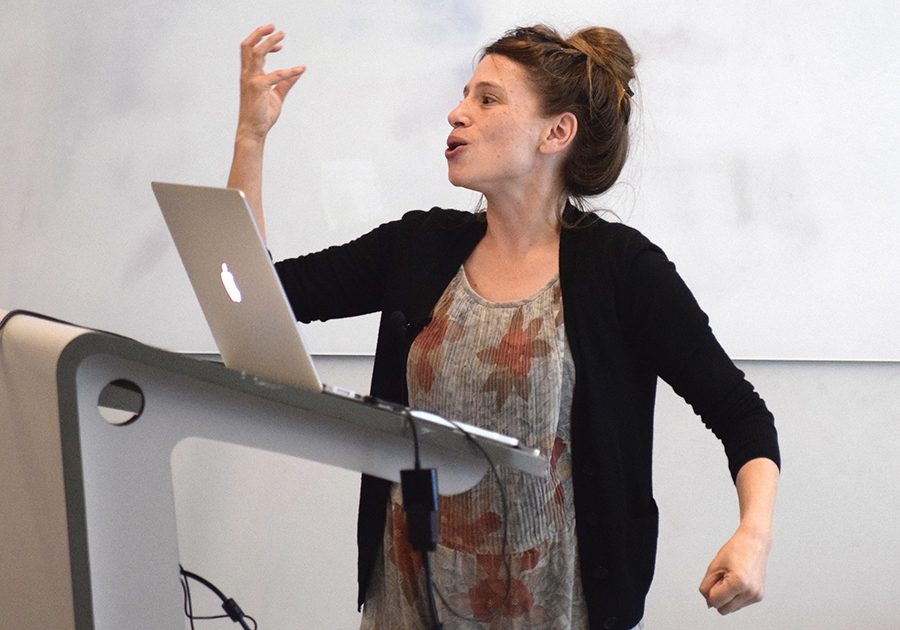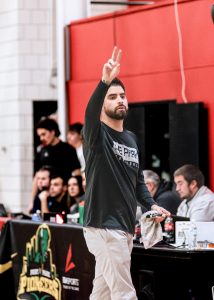Stacy Kranitz documents Appalachia through photography
Photographer shares experiences with students as first of speaker series
February 14, 2017
Last summer, three Point Park photography professors sat at a bonfire and brainstormed about artists they wanted to bring to the university.
The consensus was to bring Stacy Kranitz, the TIME 2015 Instagram Photographer of the Year, whose work has appeared in “Vice,” “Mother Jones” and “New York Times Magazine,” among others.
Ben Schonberger, in his first year as an instructor of photography at Point Park, reached out to the documentary photographer via email.
Kranitz has extensively covered the Appalachian region and its people through photographs since 2009, capturing personal moments and raw emotions through her own lens. The Kentucky-native could not turn down the opportunity.
After all, Pittsburgh is in Appalachia.
“Any invitation I get that’s in the actual region, that’s crucial,” said Kranitz after her guest lecture at the Center for Media Innovation Wednesday. “I would never say no to any opportunity to anything that’s in Appalachia. This is the rust belt. This is steel country. That’s very valid, and you wouldn’t take that away. [Pittsburgh] just happens to also be Appalachia.”
Born in Kentucky and educated in New York and California, Kranitz understood that Appalachia, specifically the central part of the region, was a poster-child for poverty. The entire Appalachian region includes 13 states from New York to Alabama, covering about 205,000 square miles.
She started exploring the land and its people to get a better sense of poverty in the region. She then began pursuing her MFA at UC Irvine. CNN soon discovered her photos from Appalachia of the people she encountered and some of those personal moments, and wanted to run them on its photo blog.
“I felt like the media was making my work awful,” Kranitz said during her lecture, citing the feeling as her reason for pursuing her MFA.
Still, she agreed to let the photos run. She explained that the images were specific ones that she took through her personal encounters with people in the region, particularly in central Appalachia. Ranging from a portrait of a coal miner to a snake handler, Kranitz did not intend to generalize the vast area.
But the headline read, “Life in Appalachia,” which brought public backlash on the internet, criticizing the photographer for assuming she knew the residents’ culture.
One commenter described the images, including one photograph with a burning cross at a Ku Klux Klan rally in Virginia, as “sensationalist crap.”
She cried for three days reading the comments, but still returned to the region, where she has spent six to eight months each year for the last eight years.
Kranitz was not done understanding the area. She wanted to continue pursuing her self-described obsession for Appalachia.
She embedded herself into towns and communities in the region, often blurring the line between her personal life and her professional life. She believes her unconventional style helps engage her subjects to better represent them in her photographs.
“She walks the line between the art world and the journalism world,” Schonberger said. “She really is able to recognize successes and failures of both, so to have her here, it’s great. She’s addressing both dynamics of our program.”
Schonberger hopes to continue building on Point Park’s visiting artist program, which will continue Feb. 18 with longtime sequence and staging photographer Duane Michals and conclude March 15 with Chris Buck, a commercial and editorial photographer.
The mixed crowd of students and professors for the first visiting artist this semester included a wide variety of backgrounds. Photojournalism, cinema, photography and dance students were some of the majors represented.
Some were familiar with Kranitz’s work before hearing her lecture, including senior photography major Dan Winter, who introduced Kranitz prior to her presentation.
“She helps inspire future work,” Winter said after the lecture. “It’s really awesome to have someone like her come to the university; someone like her who is so inspiring.
Others, like freshman cinema major Matt Mettrovich, saw her work for the first time Wednesday.
“It was eye-opening,” Mettrovich said. “I’ve never seen anyone’s work like that before. It’s not the photography I know. It’s a different genre. I respect it. Photography is a really big world. There’s a lot of different stories that can be told.”
Kranitz is continuing her work in Appalachia, specifically focusing on the stories of Donald Trump supporters as he makes policies.
She hopes that, as a result of her visit, the students begin to question the “power relationship” they have as photographers.
“I’m hoping they feel a way that they might be able to deconstruct their own work,” Kranitz said. “If I’m self-reflexive about what I’m doing, then that imparts self-reflexivity onto the industry in different ways. It’s teaching what you think should be happening, by doing it for yourself.”



















